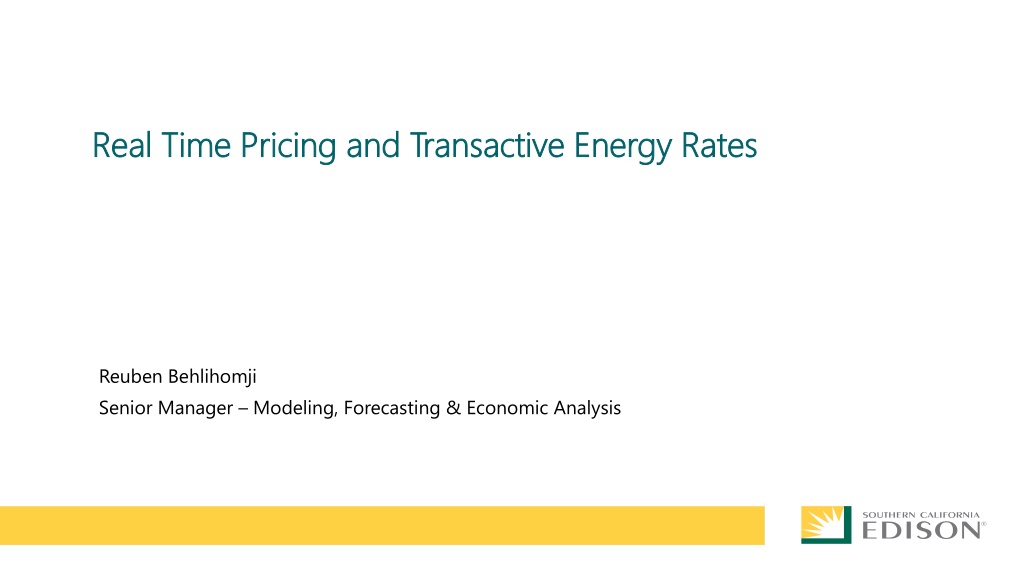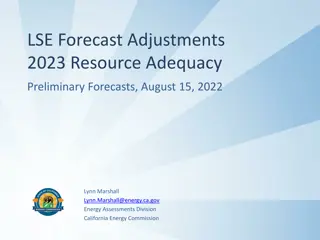Understanding Two-Part Real-Time Pricing for Energy Rates
In the world of energy economics, Two-Part Real-Time Pricing (RTP) plays a crucial role in determining electricity costs based on generation, capacity, and delivery components. This system involves partitioning usage charges into base and RTP amounts, reflecting the fluctuating nature of energy markets. Southern California Edison (SCE) employs a template-based approach for its current RTP structure, which factors in historical usage patterns and market conditions. The hourly pricing mechanism integrates generation energy, capacity costs, and revenue neutrality measures to ensure fair billing practices. Dive into the intricacies of Two-Part RTP to grasp its significance in the realm of energy management and billing.
Download Presentation

Please find below an Image/Link to download the presentation.
The content on the website is provided AS IS for your information and personal use only. It may not be sold, licensed, or shared on other websites without obtaining consent from the author. Download presentation by click this link. If you encounter any issues during the download, it is possible that the publisher has removed the file from their server.
E N D
Presentation Transcript
Real Time Pricing and Transactive Energy Rates Real Time Pricing and Transactive Energy Rates Reuben Behlihomji Senior Manager Modeling, Forecasting & Economic Analysis
Two-Part RTP | Concept Current RTP is template based where hourly prices are reflected in 7-day type pricing menus Temperature trigger Peak and ramp capacity allocated to day types based on expected capacity need Energy profiles reflect SCE s marginal generation energy cost profile Under a generation only 2-part RTP structure, usage (energy and demand) associated with generation charges is partitioned into a base amount and a RTP amount Delivery portion of the bill is considered to be entirely base usage Base usage or Base Period Usage (BPU) is predetermined based on historical usage over a set period of time (i.e., prior 12-months, 3-year average, etc.) Likely to be seasonal and reflect the prevailing TOU periods BPU structure is currently used in SCE s Schedule ME at the Port of Long Beach Bill is rendered by charging OAT generation rates for all BPU kWh and kW Delivery portion is rendered by applying metered kWh and kW to the OAT delivery charges Metered hourly kWh and kW above the baseline will be charged (or credited) at an Hourly Price 3 Southern California Edison
Two-Part RTP | Proposal (Illustrative) 4 Southern California Edison
Two-Part RTP | Hourly Price Determination Two-Part RTP Hourly Prices is comprised of generation energy and capacity Capacity component reflects both peak and flex capacity costs Hourly Capacity Adder will be triggered and valued based on an Implied Market Heat Rate (IMHR) IMHR = CAISO DLAP Price / SoCal Citygate Day Ahead Natural Gas Price Hourly Capacity Adder will be applied as an overlay to hourly energy prices in the 4-9pm period year round Daily IMHR determinants reflect the availability of peak and flex generation capacity Hourly Energy Prices will use the actual CAISO Day Ahead Energy Market Price for SP15 A scaler will be applied to ensure revenue neutrality for the Two-Part RTP rate Applied to the hourly energy prices or capacity prices, or both Recovered as a flat adder in the BPU bill Combination of all of the above 5 Southern California Edison
RATES | Concept Subscribe at specific costs and quantity for each hourly interval Monthly Fixed Subscription Cost is calculated using the Customer s SCE Tariff. The subscription is a forward contract at fixed monthly cost that stabilizes bills (cost to customer and revenue to suppliers). RATES can automatically buy and sell at the same tender prices in each interval while maintaining customer comfort, etc. Scarcity pricing used to recover more fixed (long-run marginal) cost when the delivery (in either direction) or generation system is more heavily loaded Addresses Bill and revenue volatility Grid stability Recovery of both fixed and variable costs for all parties with settlement calculations Forward transactions support better operational planning 7 Southern California Edison
RATES | Price Components CAISO Locational Marginal Price @ Transmission Interface Generation Fixed Cost (Long-Run Marginal Cost) Recovery Energy Fixed Cost Flex Fixed Cost Circuit Delivery Losses and Fixed Cost Recovery (Long-Run Marginal Cost) from Transmission Interface to Facility (can be facility specific) Fixed costs such as metering, billing, public purpose included in subscription costs 8 Southern California Edison
RATES | Transactive Hourly Prices Typical Winter Day Typical Summer Day 9 Southern California Edison






















